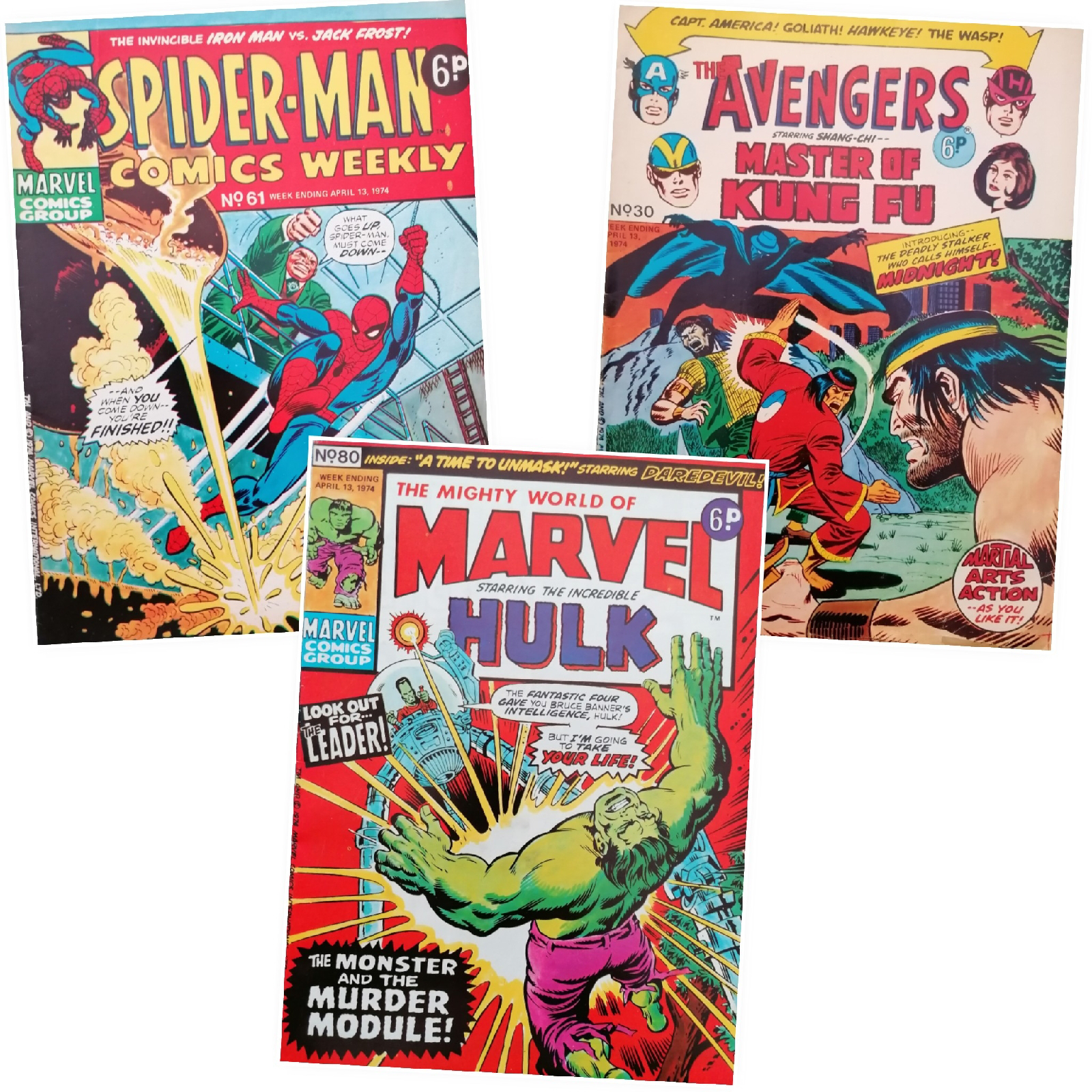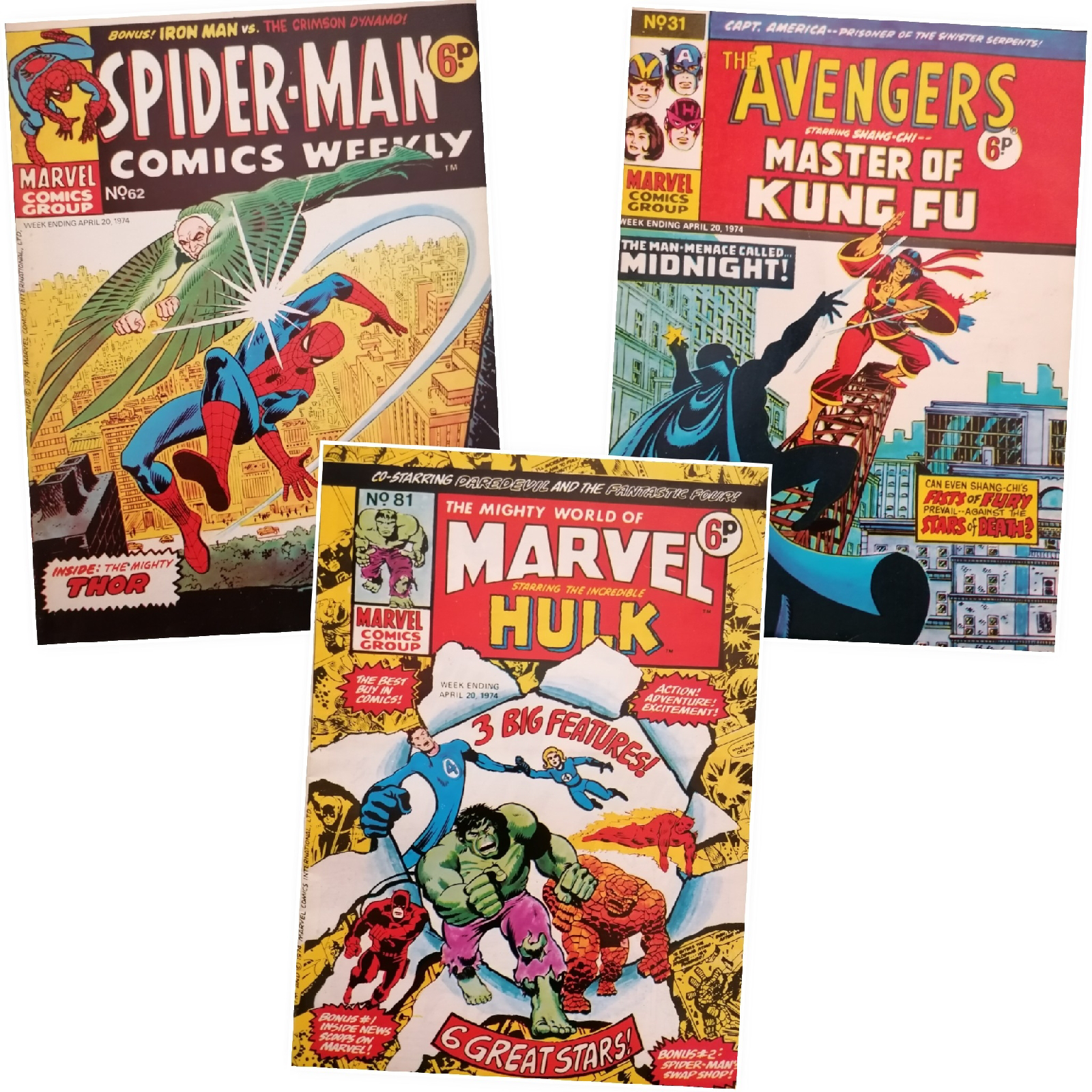Week Ending July 21, 1973
This week in 1973, the carefully constructed bubble of unique continuity constructed for the sensitive readers of the British Isles, starts to creak under the strain of its own time distorting internal logic. Can the editorial team hold together the fabric of their continuity-quilt against the growing pressure of established comic book inconsistencies?
Mighty World of Marvel #42
Another collaborative cover for MWOM this week as Marie Severin, Jack Kirby, Dan Adkins and Dick Ayers all do their bit to provide a cover that I actually quite like. Probably because at least in part, it appears to be a reworking of the original Tales to Astonish cover. As always, the colouring does its best to spoil my enjoyment.
Changes were imminent for the Hulk in 1967, with Tales to Astonish, the book he shared with the Sub-Mariner, only a couple of issues away from becoming the second eponymous title for the jade giant. Plans were also afoot to shake up the contents of MWOM in 1973. How were Marvel UK going to reconcile the two timelines? Well, it looks like they were going to fudge it, though not without some considerable style.
Hulk is still the captive of the Living Lightning, along with Betty Ross and finds himself transformed back into the form of Bruce Banner by their mysterious weapons. In a unusual turn of events, Banner and the entire missile base are singlehandedly rescued by the intervention of Glenn Talbot. The Lord of the Living Lightning is able to make good his escape, Banner realising that they have missiles ready to launch, explains that the Hulk is their only hope now. It is just as well then that General Ross, for reasons unknown, has decided to recreate Bruce's gamma ray device. Immediately transformed back into the Hulk, he sets out spectacularly destroy the base of the Living Lightning. In the original telling of this story in Tales to Astonish #99, the survival of the Hulk in the resulting explosion is left ambiguous, the more sensitive UK reader is left with no doubt by the addition of a badly drawn Hulk added to the final panel, setting up...
Now this is a clever way to get around the problem created by having two short Hulk stories per issue when you are running out of them in 1967 as he gets nearer to his own full-length tales in that period. Simply pluck out a self-contained short story set in the desert from 1972. Narratively speaking it is pretty seamless, but the change in writing and art style must have been jarring to even the most inattentive juvenile reader as Roy Thomas and Herb Trimpe take the reins from the future/recent past/ages ago (depending on your viewpoint) ripped from the pages of The Incredible Hulk #147. It is a very 70s take on the Hulk, where his loneliness manifests as a mirage of an idyllic town in the desert whose residents do not flee in fear of him. The story ends as the mirage fades and the Hulk slams his fists on the ground in rage, hard enough to register as an earthquake. Leaving us with two Hulk stories from different periods that end with an explosion or seismic event. Hmmm, I wonder if that will come in handy next week for tying up our continuity loose-ends?
The FF are still in ancient Egypt and enslaved by Rama-Tut, as with the team's previous time-travelling adventure, this turns out to be a mostly pointless affair. Kirby clearly has some fun with the historic setting and outfits, Stan gets a new recurring villain who will go on to become a pivotal part of Marvel lore, but for the most part we just get a fun, disposable yarn. Even the point of the mission, to restore Alicia's sight, is a failure as the FF find themselves unable to bring the cure back to the present for dubious 'science' reasons.
Last week's MWOM teased the arrival of Tales of Asgard in SMCW, this week we get a full-page promo for the arrival of the Avengers. While any new strip is exciting, longtime Marvel UK fans will also know that this new strip does not stay confined to the pages of MWOM for long. It won't be long before this blog gets 33% harder to write.
Spider-Man Comics Weekly #23
Rich Buckler and Mike Esposito make a reasonable job of channeling Steve Ditko to mark the meeting of his greatest creations. Less said about the Thor panel the better.
It has been mentioned right here on this blog how Marvel UK were in the business of setting up their own continuity, editing out mentions or even entire stories featuring characters who have not been formally introduced to British readers yet. The Avengers and the Silver Surfer are the two most notable casualties of this policy so far, how then would Marvel UK deal with the first crossover of Spider-Man and Dr Strange, the sorcerer supreme?
It would seem by going; "Yeah, wizards. We have wizards now". It is a bold gambit, that pays off with surprising ease, as a result we get a reasonably unmolested retelling of the second Spider-Man annual from 1965. As you might imagine, given the opportunity to play with his own toys, Ditko goes to town and for once I miss the addition of colour on the trippy visuals he provides. I have to wonder from the complete absence of Peter Parker elements in the story, if Stan left the whole thing up to Steve? No bad thing for one issue, we also get the final panel tease that we might see more of Dr Strange if he proves popular.
This week had me on high alert for edits, so the page above cobbled together from the original cover art for Journey into Mystery #105 and a pair of odd looking, clearly doctored panels, instantly set off all kinds of alarm bells. A little research showed that my suspicions were well founded, the original story featured a prologue in the Avengers Mansion before Thor flies above New York and encounters the Cobra. This element takes nothing away from the story but maintains our UK continuity. Whoever had the editing scissors in hand also took the opportunity to tidy up another element of the story that is unconnected with continuity, rather eliminates a plot device that on reading the original synopsis, only improves things. In the original telling, the Cobra meets and teams up with Mr Hyde, who tracks down Thor by means of something called the Time Reversal Ray, this improbable sounding gizmo is written out entirely and replaced by the much simpler and realistic conceit that Mr Hyde realises that there is some connection between Thor and Dr Donald Blake because of their previous encounter. To be honest, as masterful as this edit is, it would take a lot more to save any story that features an actual god struggling to deal with this pair of second-rate supervillians. Nonetheless, the effort is appreciated.











Comments
Post a Comment